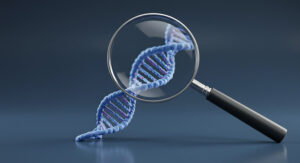When a woman becomes pregnant, the outcome of that pregnancy depends on many factors—including a crucial event that occurred while she herself was still growing in her mother’s womb. It depends on the quality of the eggs that have already formed in her fetal ovaries. The DNA-containing chromosomes in these cells must be perfectly cut, spliced, and sorted. In men, the same process takes place in the testicles, but only after puberty. “If something goes wrong, you end up with the wrong number of chromosomes in the eggs or sperm,” said Neil Hunter, professor at the Department of Microbiology and Molecular Genetics at the University of California, Davis. “This can lead to infertility, miscarriages, or the birth of children with genetic disorders.”
New Insights Into Why Reproductive Disorders Occur
In an article published in the journal Nature, Hunter’s team reports an important new discovery about a process that helps protect against such errors. He has pieced together the choreography of the proteins that connect matching chromosome pairs – ensuring that they are correctly sorted during the development and division of egg and sperm cells. Hunter’s discoveries required methods that allowed the molecular processes of chromosome recombination to be observed in unprecedented detail. This required genetic engineering of budding yeast, a model organism that has been used for decades to study the functioning of fundamental cellular processes. “The chromosome structures we studied have changed very little over the course of evolution,” Hunter said. “Every protein we studied in yeast has a direct counterpart in humans.” His findings could improve our understanding of fertility problems and their diagnosis and treatment in humans.
Formation of Chromosome Crossovers for Strong Connections
Humans have 46 chromosomes in each cell, consisting of 23 pairs of identical, “homologous” chromosomes, with each pair inherited equally from both parents. At the beginning of sperm or egg cell formation, these chromosome pairs line up next to each other, and the parental chromosomes break and reconnect with each other. These chromosome exchanges, known as “crossovers,” also called crossovers, serve two important functions. First, they help ensure that each chromosome passed on to offspring contains a unique mix of genes from both parents. Crossovers also ensure that chromosomes remain connected in matching pairs. These connections control the distribution of chromosomes when cells divide to produce eggs and sperm. According to Hunter, maintaining crossover connections is particularly important in women.
When chromosomes pair up in developing eggs or sperm, matching strands of DNA are exchanged and twisted together over a short distance to form a structure called a “double Holliday junction.” The DNA strands of this structure are then cut to join the chromosomes and form a crossover. In males, the developing immature sperm divide immediately, distributing the chromosomes to the sperm. In contrast, the egg cells developing in the fetal ovary stop developing after the crossovers have formed. The immature egg cells can remain in a state of suspended animation for decades after birth until they are activated to undergo ovulation.
Only then does the process resume: the egg cell finally divides, and the chromosome pairs that were connected by crossover are permanently separated to provide a single set of chromosomes to the mature egg cell. “Maintaining crossover connections over many years is a major challenge for immature eggs,” Hunter said. If chromosome pairs are not connected by at least one crossover, they can lose contact with each other, like two people who are separated in a jostling crowd. This causes them to divide incorrectly during final cell division, resulting in eggs with extra or missing chromosomes. This can lead to infertility, miscarriage, or genetic disorders such as Down syndrome, in which a child is born with an extra copy of chromosome 21, resulting in cognitive impairment, heart defects, hearing loss, and other problems.
Research Project on Yeast is of Great Importance for Human Reproduction
Hunter has spent years trying to understand how crossovers arise and how this process can fail and lead to reproductive problems. By studying this process in yeast, researchers can directly visualize the molecular events involved in the resolution of double Holliday connections (X-shaped structures in DNA that play a central role in genetic recombination and DNA repair) in synchronized cell populations. Researchers have identified dozens of proteins that bind and process these connections. Hunter and then-postdoctoral fellow Shangming Tang (now assistant professor of biochemistry and molecular genetics at the University of Virginia) used a technique called “real-time genetics” to study the function of these proteins. Using this method, they caused the cells to degrade one or more specific proteins within the structures associated with the junctions.
They were then able to analyze the DNA of these cells to determine whether the connections had been dissolved and whether they had formed crossovers. In this way, they created a picture in which a network of proteins works together to ensure the formation of crossovers. “This strategy allowed us to answer a question that was previously impossible,” Hunter said. They identified important proteins, such as cohesin, that prevent an enzyme called the STR complex (or Bloom complex in humans) from inappropriately degrading the junctions before they can form crossovers. “They protect the double Holliday junction,” Hunter said. “That’s an important discovery.” This years-long research project on yeast is highly relevant to human reproduction, as the process has changed little over the course of evolution. Failure to protect double Holliday junctions could be linked to fertility problems in humans.





